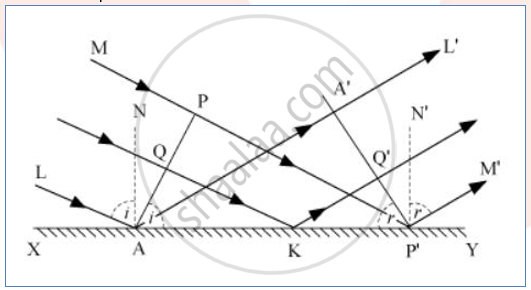Advertisements
Advertisements
प्रश्न
Define the term wavefront. Using Huygen’s wave theory, verify the law of reflection.
उत्तर
In a region where the wave is propagating, the geometrical structure formed by joining all the points which are vibrating in same (absolute) phase are said to be wavefront Reflection of plane wave :

Consider a plane wave ABC incident at an angle ‘i’ on a reflecting surface ‘AD’. If v represents the speed of the wave in medium Δt is the time taken to move from ABC to B1C1 and also from B1C1 to point ‘D’. So, at the time when a disturbance of point ‘C’ reaches to point ‘D’ disturbance of point ‘A’ must have formed a hemispherical shape of radius 2vΔt and at point ‘B1’ it must have formed a hemispherical shape of radius vΔt. Drawing a common tangent from point ‘D’ to both of the above mentioned spherical envelopes we shall have DEF as reflected wavefront. Now, in ΔACD and ΔDFA

Side AD = AD and side CD = AF = 2vΔt
And ∠ACD = ∠DFA = 90°
so by RHS rule, both the triangles are congruent. Hence each corresponding parameter must be the same. Hence ∠CAD = i (angle of incidence) Must be the same as ∠FDA = r (angle of reflection) ∠i = ∠r
APPEARS IN
संबंधित प्रश्न
You have learnt in the text how Huygens’ principle leads to the laws of reflection and refraction. Use the same principle to deduce directly that a point object placed in front of a plane mirror produces a virtual image whose distance from the mirror is equal to the object distance from the mirror.
Using this principle draw a diagram to show how a plane wave front incident at the interface of the two media gets refracted when it propagates from a rarer to a denser medium. Hence verify Snell's law of refraction.
Use Huygens’s principle to explain the formation of diffraction pattern due to a single slit illuminated by a monochromatic source of light.
Huygens' principle of secondary wavelets may be used to
(a) find the velocity of light in vacuum
(b) explain the particle behaviour of light
(c) find the new position of a wavefront
(d) explain Snell's Law
Light waves travel in vacuum along the X-axis. Which of the following may represent the wave fronts?
Answer the following question.
Define the term wavefront. Using Huygen's wave theory, verify the law of reflection.
What is the phase difference between any two points lying on the same?
What is the shape of the wavefront on earth for sunlight?
What type of wavefronts are associated with a point source of light?
Represent diagrammatically how the incident planar wavefronts of wavelength λ pass through an aperture of size d, when d is approximately equal to λ.
